Environmental and Economic Aspects of a Containership Engine Performance in Off-Design Conditions
Abstract
:1. Introduction
2. Containership and Propeller Characteristics
3. Methodology
| Engine Name | Wartsila Sulzer RTA-96C |
|---|---|
| Type | two-stroke diesel, turbocharged, liquid cooling |
| Scavenging type | unidirectional with exhaust valve |
| Fuel | MDF—marine diesel fuel (LHV = 42.7 MJ/kg) |
| Cylinder bore | 960 mm |
| Piston stroke | 2500 mm |
| Maximum engine speed | 120 rpm |
| Maximum BMEP * | 19.6 bar |
| Maximum brake power * | 5490 kW per cylinder |
| BSFC at max. constant rating (at R1 operating point) * (ISO 3046-1) [33] | 171 g/kWh |
| Cylinder arrangement and numbers (this study) | inline; 6, 7 and 8 cylinders |
3.1. Engine Simulation Model
3.2. Validation of 1D/0D Simulation Model
4. Results and Discussions
4.1. Fuel Consumption and Emissions
4.2. Engine Configuration with Six, Seven and Eight Cylinders
4.3. Off-Design Conditions
5. Conclusions
- The application of the 1D/0D simulation model and propeller-delivered power function can be a useful step for the calculation of ship engine performance and exhaust gas emissions in off-design conditions typical for slow steaming.
- The lowest engine speed, which the engine can safely sustain, varies between engine variants. The lowest achievable sailing speed for six-cylinder and seven-cylinder engines is 15 knots, and for the eight-cylinder engine, it is 17 knots.
- The reduction in sailing speed by 35% (from 23 knots to 15 knots) for ship powered by the six-cylinder engine variant resulted in the reduction in CO2, NOX, and soot by 67.1%, 89.6% and 53.4%, respectively, and that engine variant provides the highest income per route.
- The income for the analyzed Trans-Pacific route at the sailing speed of 15 knots is increased by 6.2%, while the annual income is decreased by 32.8% because a longer sailing time per route is required.
- To satisfy the targeted 55% reduction in GHG emissions by 2030 under slow steaming conditions, the sailing speed should be reduced by at least 26% compared to the design speed. Such a reduction can be achieved with all engine variants at sailing speed of 17 knots, in which case the eight-cylinder engine variant ensures the highest reduction in CO2 emission (55%), NOX emission (87.4%) and the highest annual income decrease (23.7%).
Author Contributions
Funding
Institutional Review Board Statement
Informed Consent Statement
Data Availability Statement
Acknowledgments
Conflicts of Interest
Acronyms and Nomenclature
| Acronyms | |
| 0D | zero-dimensional |
| 1D | one-dimensional |
| 3D | three-dimensional |
| CO1 | air cooler |
| CO2 | carbon dioxide |
| CPP | controllable pitch propeller |
| EEXI | energy efficiency existing ship index |
| EU | European Union |
| ETS | emission trading system |
| FSN | filter smoke number |
| GHG | greenhouse gases |
| IMO | international maritime organization |
| ITTC | international towing tank conference |
| NOX | nitrogen oxides |
| FEU | forty-foot equivalent units |
| PL1 | plenum |
| TC1 | turbocharger |
| TDC | top dead center |
| TEU | twenty-foot equivalent units |
| VP | variable plenum |
| Nomenclature | |
| BMEP | brake mean effective pressure [bar] |
| BSFC | brake specific fuel consumption [g/kWh] |
| LHV | lower heating value [MJ/kg] |
| expanded blade area ratio [-] | |
| soot formation tuning parameter [-] | |
| soot oxidation tuning parameter [-] | |
| B | breadth [m] |
| block coefficient [-] | |
| longitudinal prismatic coefficient [-] | |
| midship section coefficient [-] | |
| waterplane area coefficient [-] | |
| ratio of the hub diameter to the propeller diameter (hub ratio) [-] | |
| D | diameter [m] |
| activation energy for soot formation [J/mol] | |
| activation energy of soot oxidation [J/mol] | |
| coefficient of Arrhenius-type form [-] | |
| longitudinal center of buoyancy (with respect to midship) [m] | |
| length between perpendiculars [m] | |
| length of waterline [m] | |
| mass of fuel burned by diffusion flame [kg] | |
| actual soot mass [kg] | |
| mass of formatted soot [kg] | |
| mass of soot that oxides [kg] | |
| fixed soot model constants [-] | |
| pitch ratio [-] | |
| p | in-cylinder pressure [Pa] |
| partial pressure of oxygen [Pa] | |
| reference partial pressure of oxygen [Pa] | |
| reference pressure [Pa] | |
| r | reaction rate [kmol/s] |
| individual gas constant [J/(kgK)] | |
| S | wetted surface area [m2] |
| T | burned zone temperature [K] |
| draught at aft perpendicular [m] | |
| TF | draught at forward perpendicular [m] |
| TM | draught at midship [m] |
| Z | number of propeller blades [-] |
| ZCB | vertical center of buoyancy [m] |
| ∇ | displacement volume [m3] |
| τchar | characteristic mixing time [s] |
References
- International Maritime Organization. 2023 IMO Strategy on Reduction of GHG Emissions from Ships; Annex 1, Resolution MEPC.377(80); IMO: London, UK, 2023. [Google Scholar]
- European Comission, Regulation (EU) 2023/957 of the European Parliament and of the Council. Available online: https://eur-lex.europa.eu/eli/reg/2023/957 (accessed on 18 February 2024).
- Chua, Y.J.; Soudagar, I.; Ng, S.H.; Meng, Q. Impact analysis of environmental policies on shipping fleet planning under demand uncertainty. Transp. Res. D Transp. Environ. 2023, 120, 103744. [Google Scholar] [CrossRef]
- Tuswan, T.; Sari, D.P.; Muttaqie, T.; Prabowo, A.R.; Soetardjo, M.; Murwantono, T.T.P.; Utina, R.; Yuniati, Y. Representative application of LNG-fuelled ships: A critical overview on potential GHG emission reductions and economic benefits. Brodogradnja 2023, 74, 63–83. [Google Scholar] [CrossRef]
- Dotto, A.; Satta, F.; Campora, U. Energy, environmental and economic investigations of cruise ships powered by alternative fuels. Energy Convers. Manag. 2023, 285, 117011. [Google Scholar] [CrossRef]
- Bayraktar, M.; Yuksel, O. A scenario-based assessment of the energy efficiency existing ship index (EEXI) and carbon intensity indicator (CII) regulations. Ocean Eng. 2023, 278, 114295. [Google Scholar] [CrossRef]
- Horvath, S.; Fasihi, M.; Breyer, C. Techno-economic analysis of a decarbonized shipping sector: Technology suggestions for a fleet in 2030 and 2040. Energy Convers. Manag. 2018, 164, 230–241. [Google Scholar] [CrossRef]
- Xing, H.; Spence, S.; Chen, H. A comprehensive review on countermeasures for CO2 emissions from ships. Renew. Sustain. Energy Rev. 2020, 134, 110222. [Google Scholar] [CrossRef]
- United Nations. Review of Maritime Transport. Available online: https://unctad.org/system/files/official-document/rmt2023_en.pdf (accessed on 18 February 2024).
- Czermański, E.; Oniszczuk-Jastrząbek, A.; Spangenberg, E.F.; Kozłowski, L.; Adamowicz, M.; Jankiewicz, J.; Cirella, G.T. Implementation of the Energy Efficiency Existing Ship Index: An important but costly step towards ocean protection. Mar. Policy 2022, 145, 105259. [Google Scholar] [CrossRef]
- Braidotti, L.; Bertagna, S.; Rappoccio, R.; Utzeri, S.; Bucci, V.; Marinò, A. On the inconsistency and revision of Carbon Intensity Indicator for cruise ships. Transp. Res. D Transp. Environ. 2023, 118, 103662. [Google Scholar] [CrossRef]
- Godet, A.; Nurup, J.N.; Saber, J.T.; Panagakos, G.; Barfod, M.B. Operational cycles for maritime transportation: A benchmarking tool for ship energy efficiency. Transp. Res. D Transp. Environ. 2023, 121, 103840. [Google Scholar] [CrossRef]
- Farkas, A.; Degiuli, N.; Martić, I.; Grlj, C.G. Is slow steaming a viable option to meet the novel energy efficiency requirements for containerships? J. Clean. Prod. 2022, 374, 133915. [Google Scholar] [CrossRef]
- Marques, C.H.; Pereda, P.C.; Lucchesi, A.; Ramos, R.F.; Fiksdahl, O.; Assis, L.F.; Pereira, N.N.; Caprace, J.D. Cost and environmental impact assessment of mandatory speed reduction of maritime fleets. Mar. Policy 2023, 147, 105334. [Google Scholar] [CrossRef]
- Finnsgård, C.; Kalantari, J.; Roso, V.; Woxenius, J. The Shipper’s perspective on slow steaming-Study of Six Swedish companies. Transp. Policy 2020, 86, 44–49. [Google Scholar] [CrossRef]
- Wu, W.M. The optimal speed in container shipping: Theory and empirical evidence. Transp. Res. E Logist. Transp. 2020, 136, 101903. [Google Scholar] [CrossRef]
- Kalajdžić, M.; Vasilev, M.; Momčilović, N. Power reduction considerations for bulk carriers with respect to novel energy efficiency regulations. Brodogradnja 2022, 73, 79–92. [Google Scholar] [CrossRef]
- Tran, N.K.; Lam, J.S.L. Effects of container ship speed on CO2 emission, cargo lead time and supply chain costs. Res. Transp. Bus. 2022, 43, 100723. [Google Scholar] [CrossRef]
- Farkas, A.; Degiuli, N.; Martić, I.; Mikulić, A. Benefits of slow steaming in realistic sailing conditions along different sailing routes. Ocean Eng. 2023, 275, 114143. [Google Scholar] [CrossRef]
- Yu, H.; Fang, Z.; Fu, X.; Liu, J.; Chen, J. Literature review on emission control-based ship voyage optimization. Transp. Res. D Transp. Environ. 2021, 93, 102768. [Google Scholar] [CrossRef]
- Berthelsen, F.H.; Nielsen, U.D. Prediction of ships’ speed-power relationship at speed intervals below the design speed. Transp. Res. D Transp. Environ. 2021, 99, 102996. [Google Scholar] [CrossRef]
- Psaraftis, H.N.; Lagouvardou, S. Ship speed vs. power or fuel consumption: Are laws of physics still valid? Regression analysis pitfalls and misguided policy implications. Clean. Logist. Supply Chain 2023, 7, 100111. [Google Scholar] [CrossRef]
- Lee, C.Y.; Lee, H.L.; Zhang, J. The impact of slow ocean steaming on delivery reliability and fuel consumption. Transp. Res. E Logist. Transp. 2015, 76, 176–190. [Google Scholar] [CrossRef]
- Zincir, B. Slow steaming application for short-sea shipping to comply with the CII regulation. Brodogradnja 2023, 74, 21–38. [Google Scholar] [CrossRef]
- Degiuli, N.; Martić, I.; Farkas, A.; Buča, M.P.; Dejhalla, R.; Grlj, C.G. Experimental assessment of the hydrodynamic characteristics of a bulk carrier in off-design conditions. Ocean Eng. 2023, 280, 114936. [Google Scholar] [CrossRef]
- Zhang, F.; Chen, Y.; Su, P.; Cui, M.; Han, Y.; Matthias, V.; Wang, G. Variations and characteristics of carbonaceous substances emitted from a heavy fuel oil ship engine under different operating loads. Environ. Pollut. 2021, 284, 117388. [Google Scholar] [CrossRef] [PubMed]
- Guan, C.; Theotokatos, G.; Zhou, P.; Chen, H. Computational investigation of a large containership propulsion engine operation at slow steaming conditions. Appl. Energy 2014, 130, 370–383. [Google Scholar] [CrossRef]
- Di Natale, F.; Carotenuto, C. Particulate matter in marine diesel engines exhausts: Emissions and control strategies. Transp. Res. D Transp. Environ. 2015, 40, 166–191. [Google Scholar] [CrossRef]
- Duan, K.; Li, Q.; Liu, H.; Zhou, F.; Lu, J.; Zhang, X.; Zhang, Z.; Wang, S.; Ma, Y.; Wang, X. Dynamic NOx emission factors for main engines of bulk carriers. Transp. Res. D Transp. Environ. 2022, 107, 103290. [Google Scholar] [CrossRef]
- Brodarski Institute. Resistance, Self-Propulsion and 3D Wake Measurement Test Results; Report 6652-M; Brodarski Institute: Zagreb, Croatia, 2022. [Google Scholar]
- AVL BOOST, version 2013. Computer software. AVL List GmbH: Graz, Austria, 2013.
- Demmerle, R. Sulzer RTA-C, Technology Review—Sulzer RTA84C and RTA96C Engines: The Reliable Driving Forces for Large, Fast Containerships; Wärtsillä NSD Swizerland Ltd.: Winterthur, Switzerland, 1997. [Google Scholar]
- ISO 3046-1:2002; Reciprocating Internal Combustion Engine—Performance, Part 1: Declarations of Power, Fuel and Lubrication Oil Consumption, and Test Methods—Additional Requirements for Engines for General Use. Edition 5; ISO: Geneva, Switzerland, 2002.
- Sjerić, M.; Krajnović, J.; Vučetić, A.; Kozarac, D. Influence of Swirl Flow on Combustion and Emissions in Spark-Ignition Experimental Engine. J. Energy Eng. 2021, 147, 04021014. [Google Scholar] [CrossRef]
- Schubiger, R.A.; Boulouchos, K.; Eberle, M.K. Rußbildung und Oxidation bei der dieselmotorischen Verbrennung. MTZ-Mot. Z. 2002, 63, 342–353. [Google Scholar] [CrossRef]
- United Nations. Review of Maritime Transport. Chapter 3: Freight Rates, Maritime Transport Costs and Their Impact on Prices. 2021. Available online: https://unctad.org/system/files/official-document/rmt2021_en_0.pdf (accessed on 19 February 2024).
- Bilousov, I.; Bulgarkov, M.; Savchuk, V. Modern Marine Internal Combustion Engines—A Technical and Historical Overview; Springer Nature: Cham, Switzerland, 2020; Volume 8, pp. 347–349. [Google Scholar]
- The Geography of Transport Systems—Operating Costs of Panamax and Post-Panamax Containerships. Available online: https://transportgeography.org/contents/chapter5/maritime-transportation/containerships-operating-costs-panamax-post-panamax/ (accessed on 19 February 2024).
- Ship & Bunker—Hong Kong Bunker Prices. Available online: https://shipandbunker.com/prices/apac/ea/cn-hok-hong-kong#VLSFO (accessed on 19 February 2024).

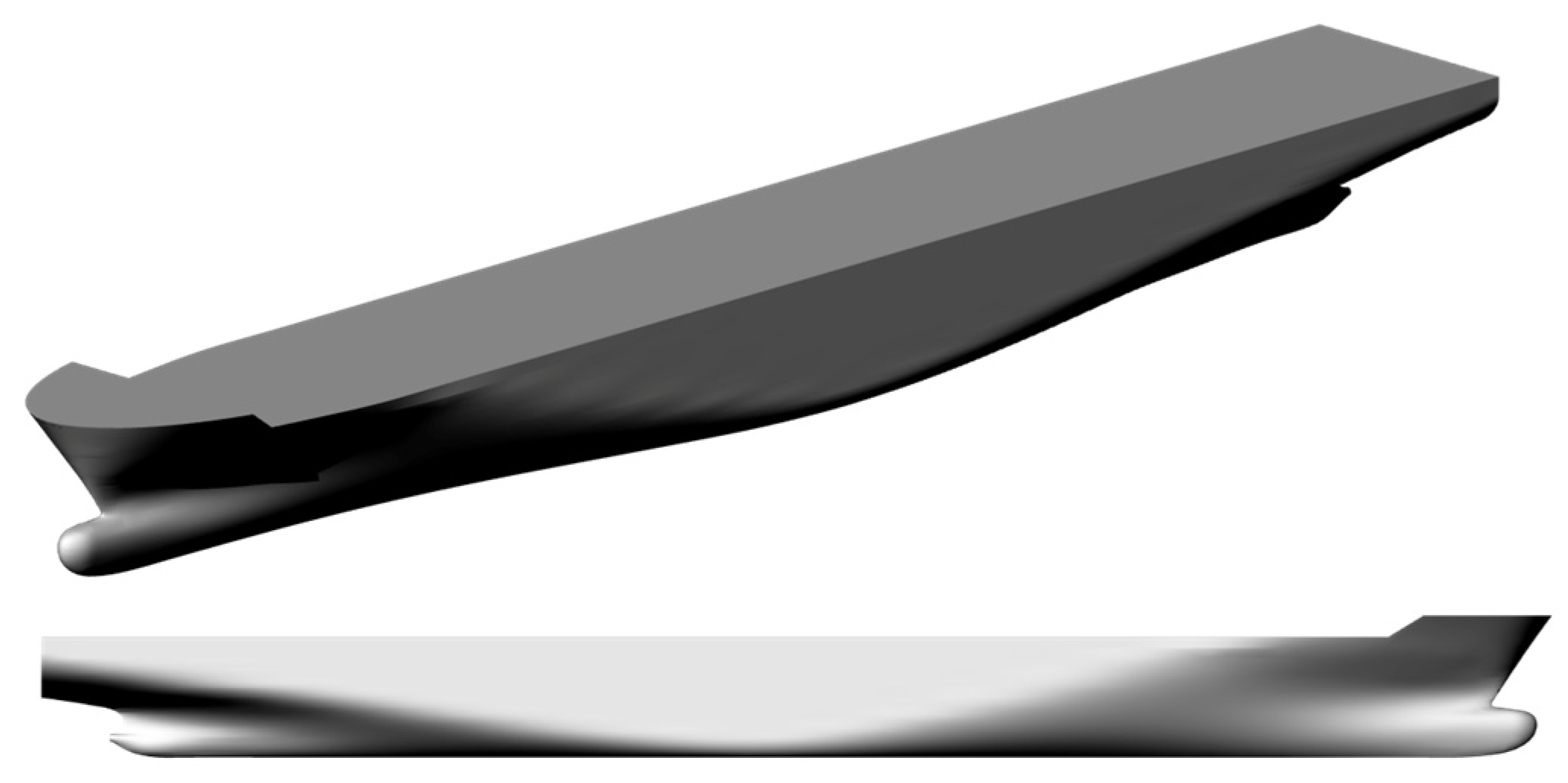
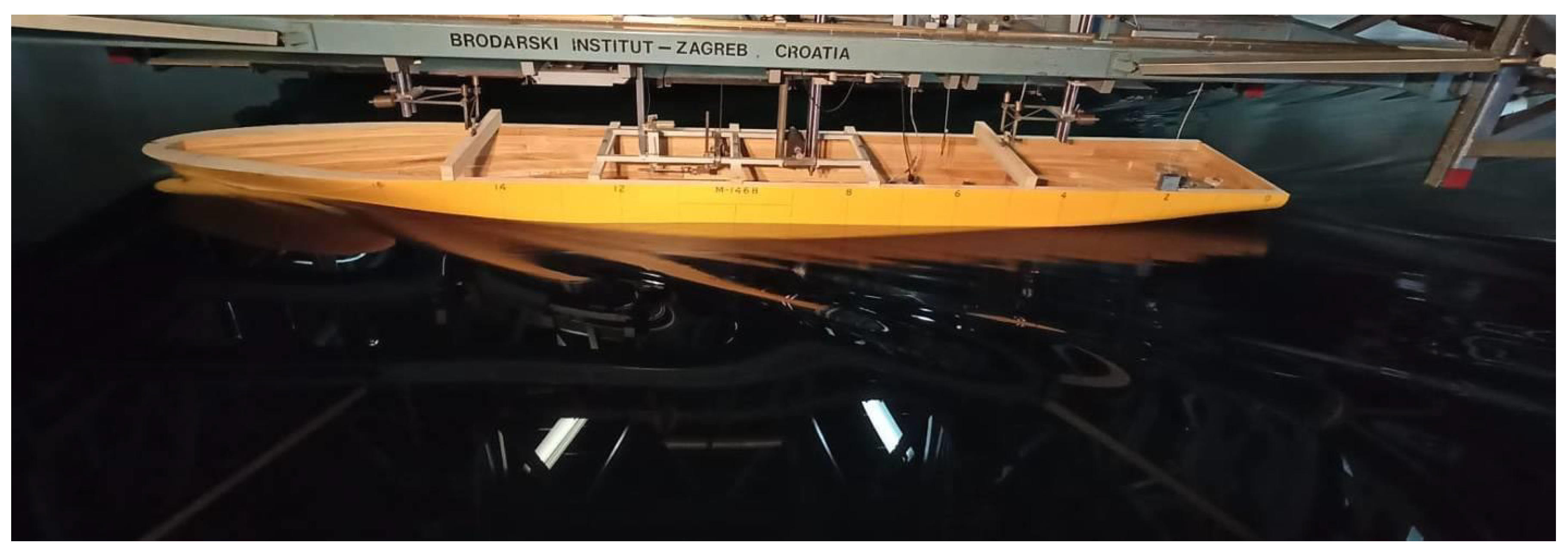
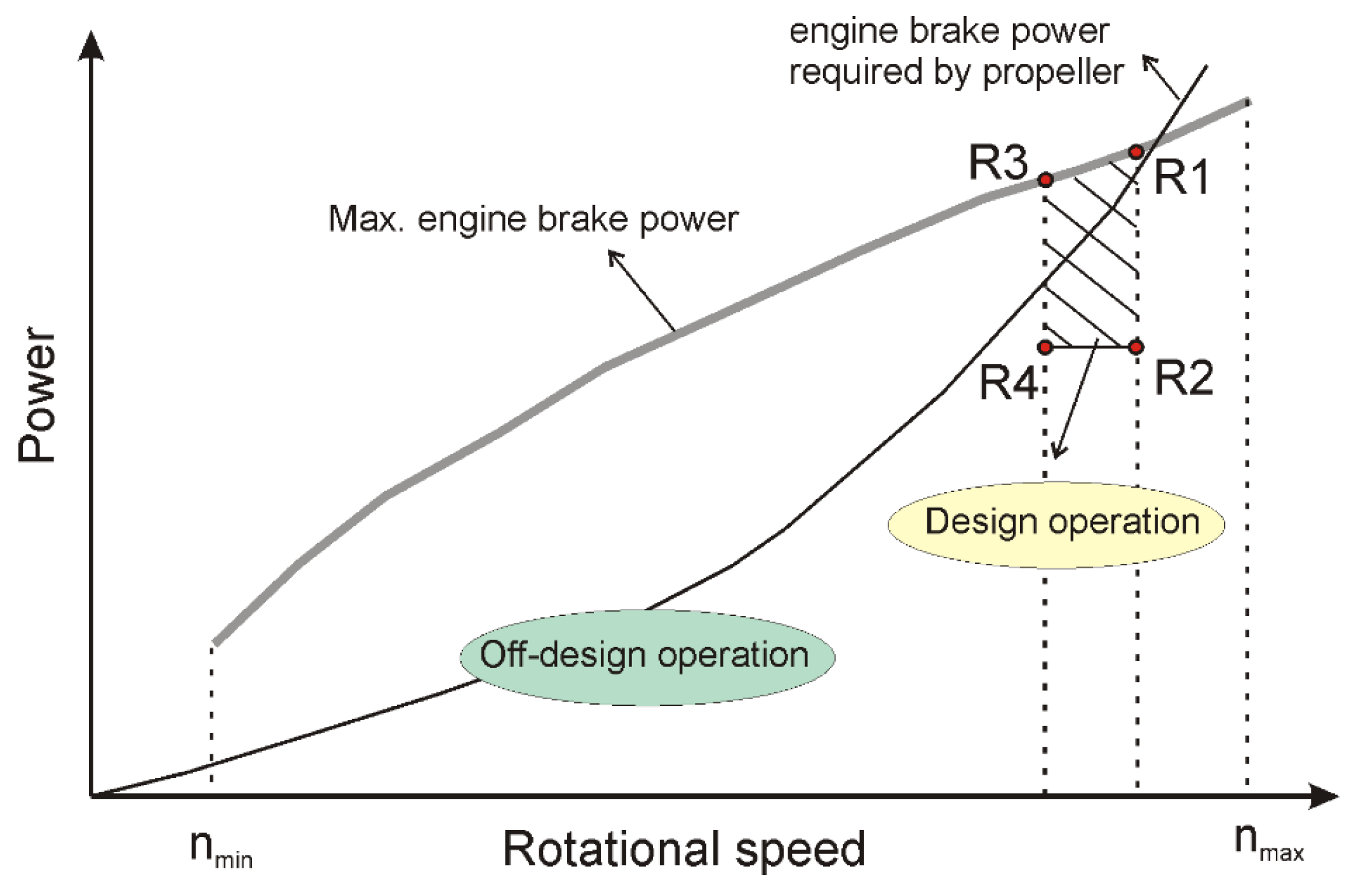
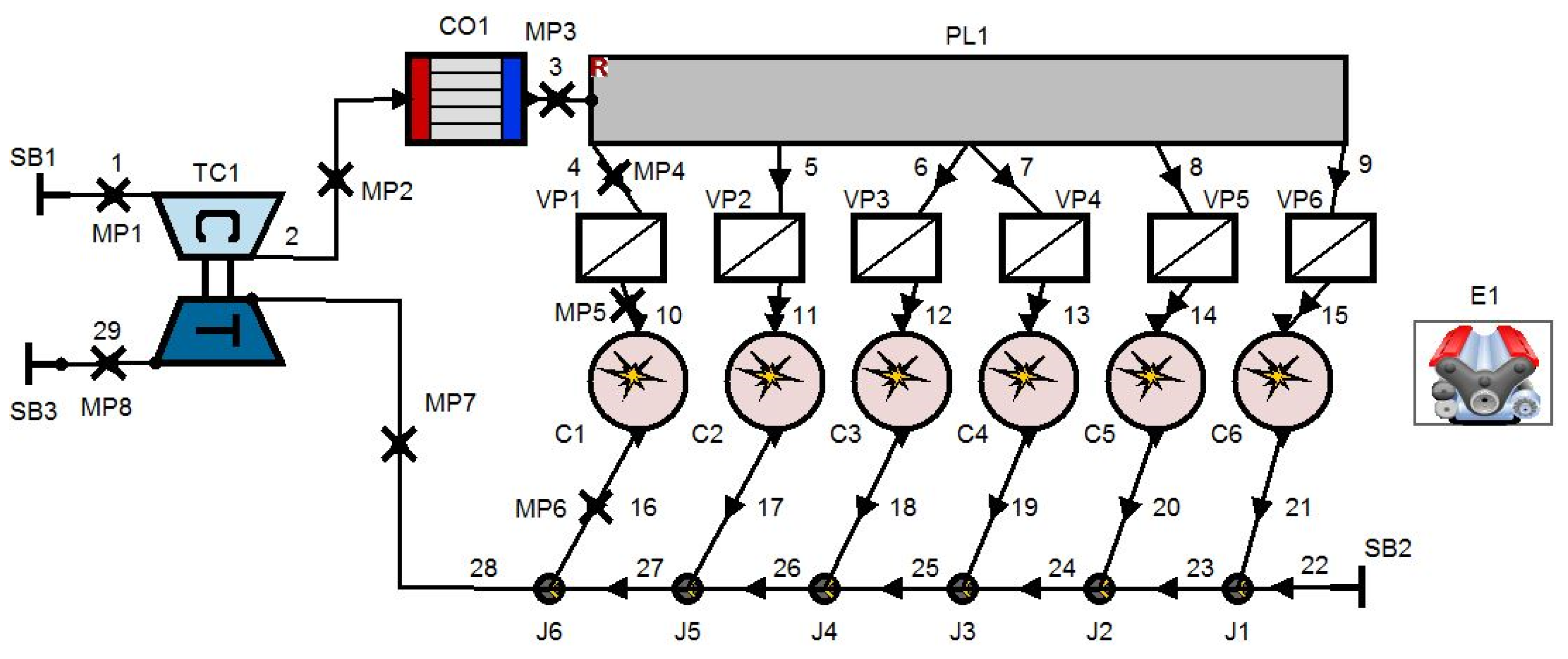
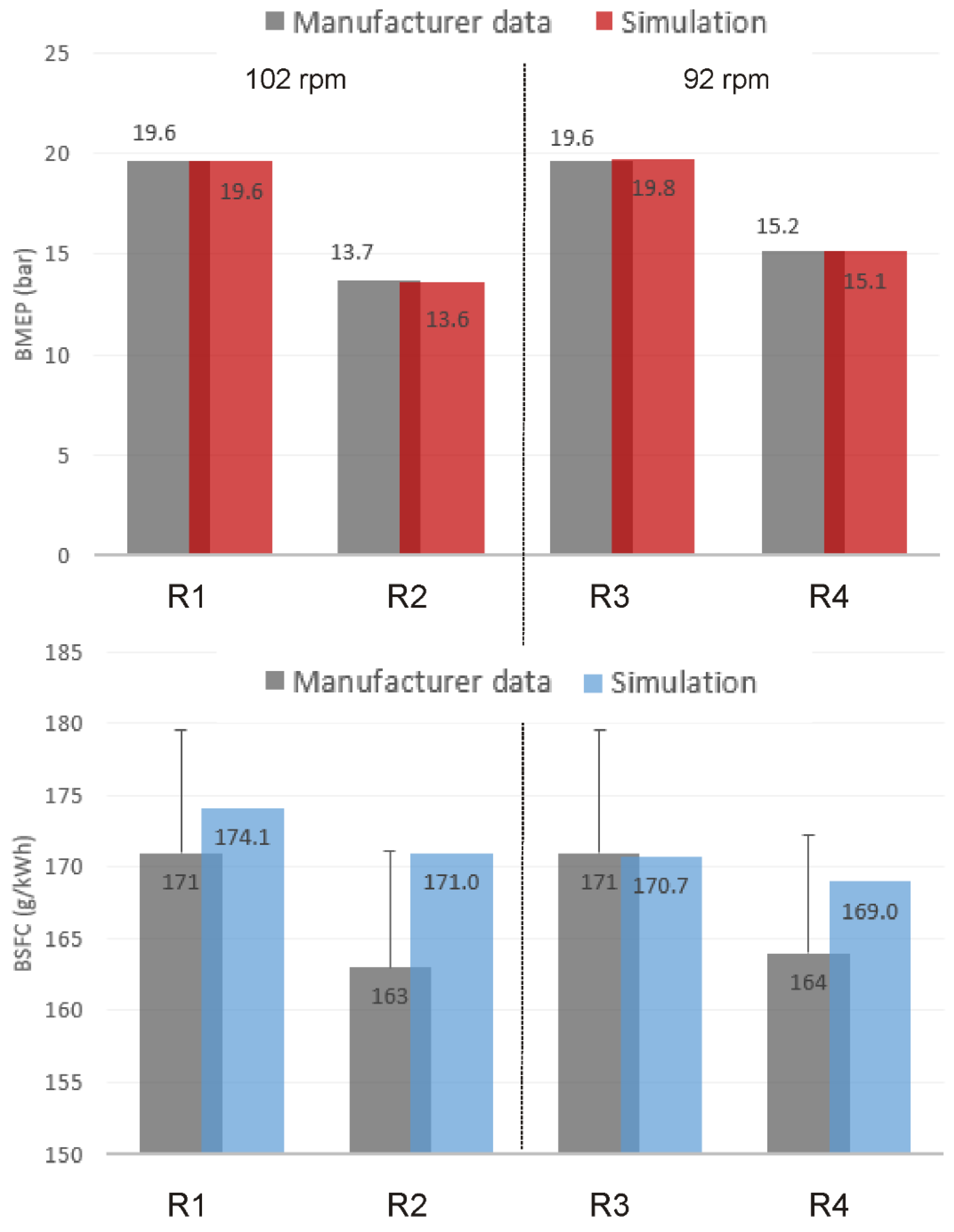
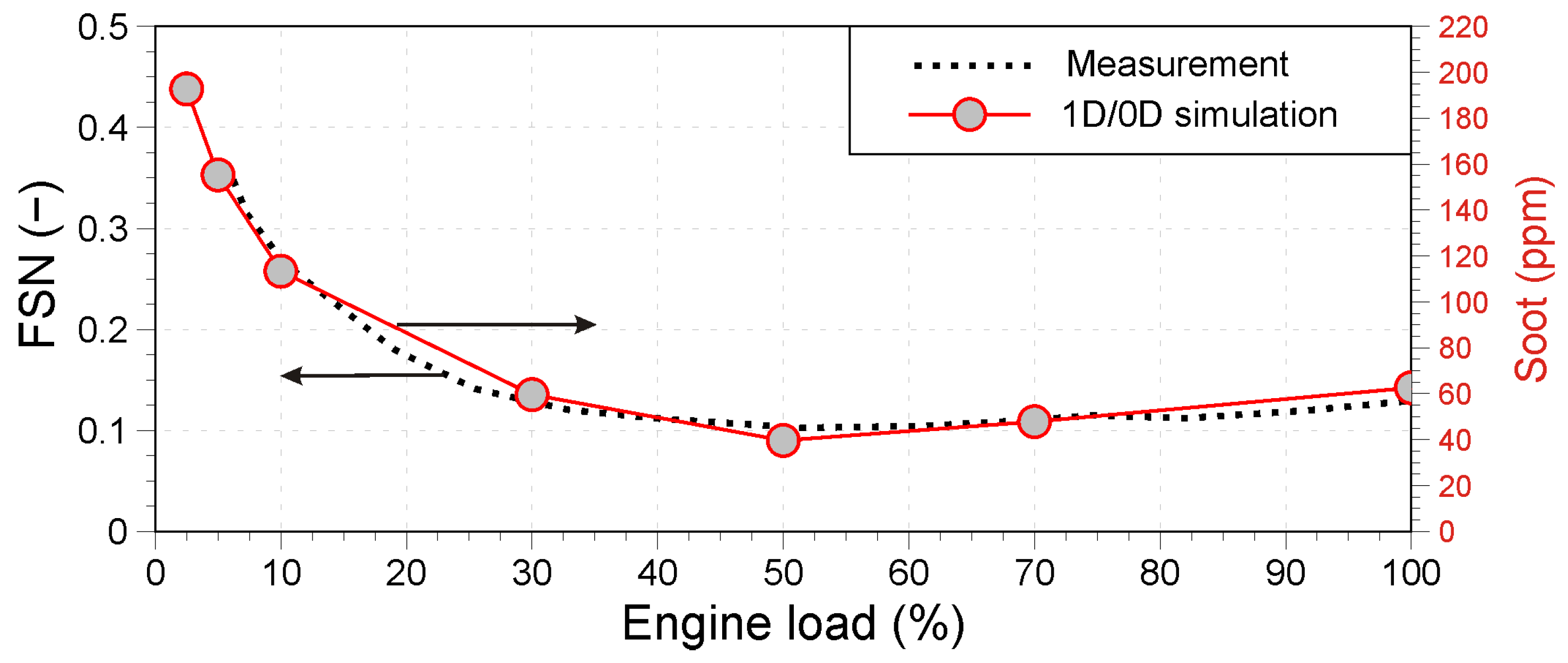

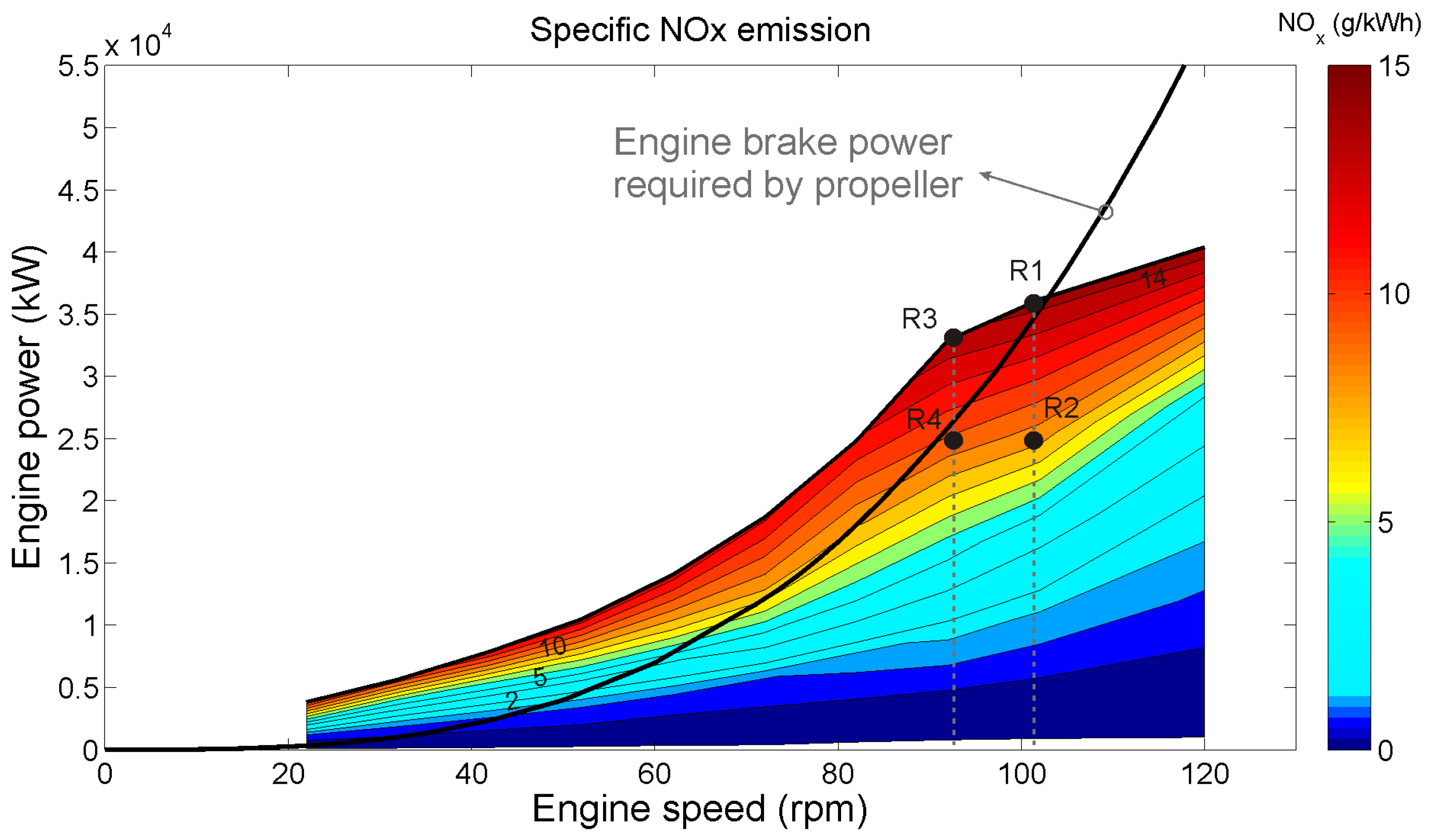


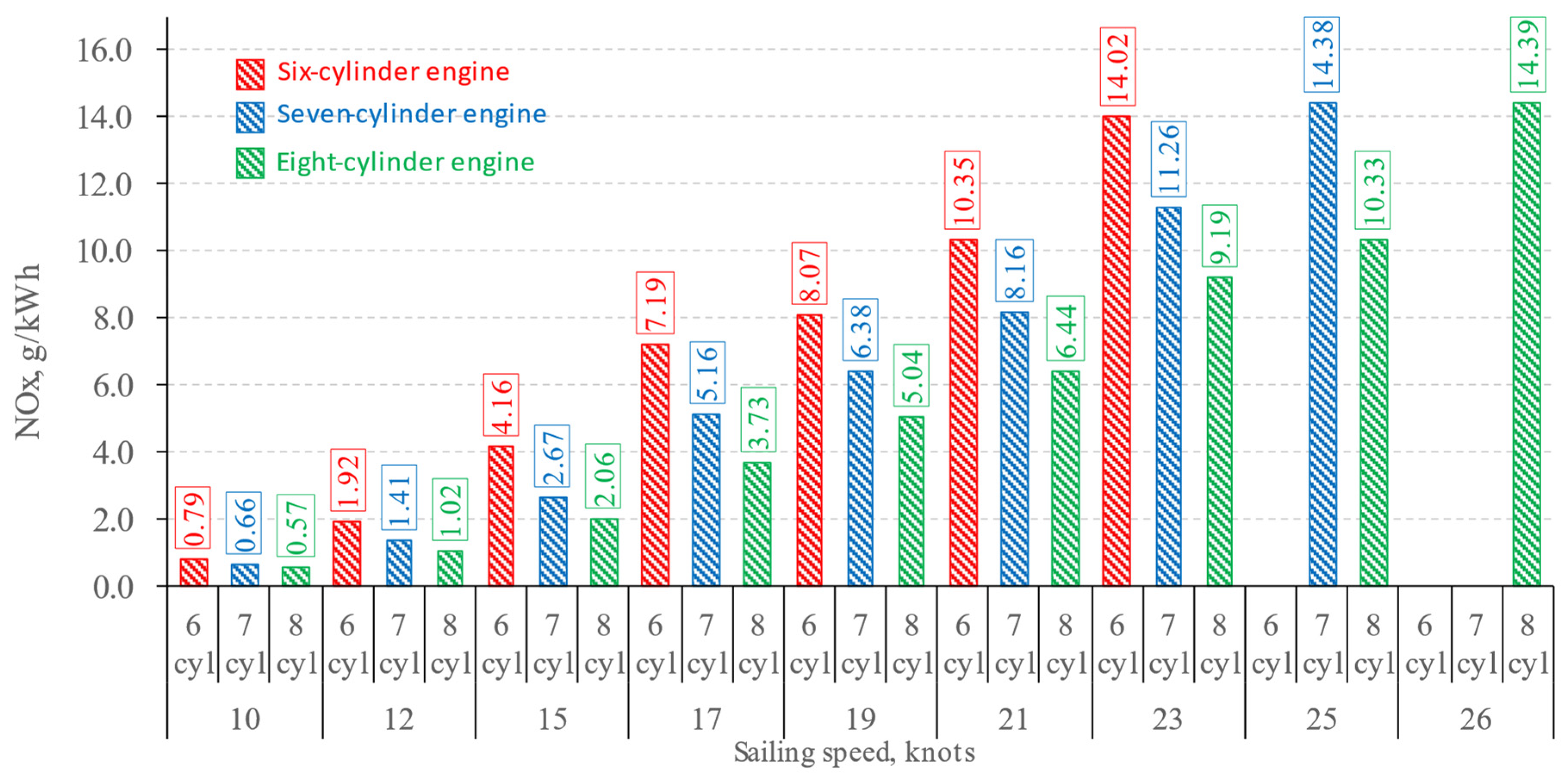

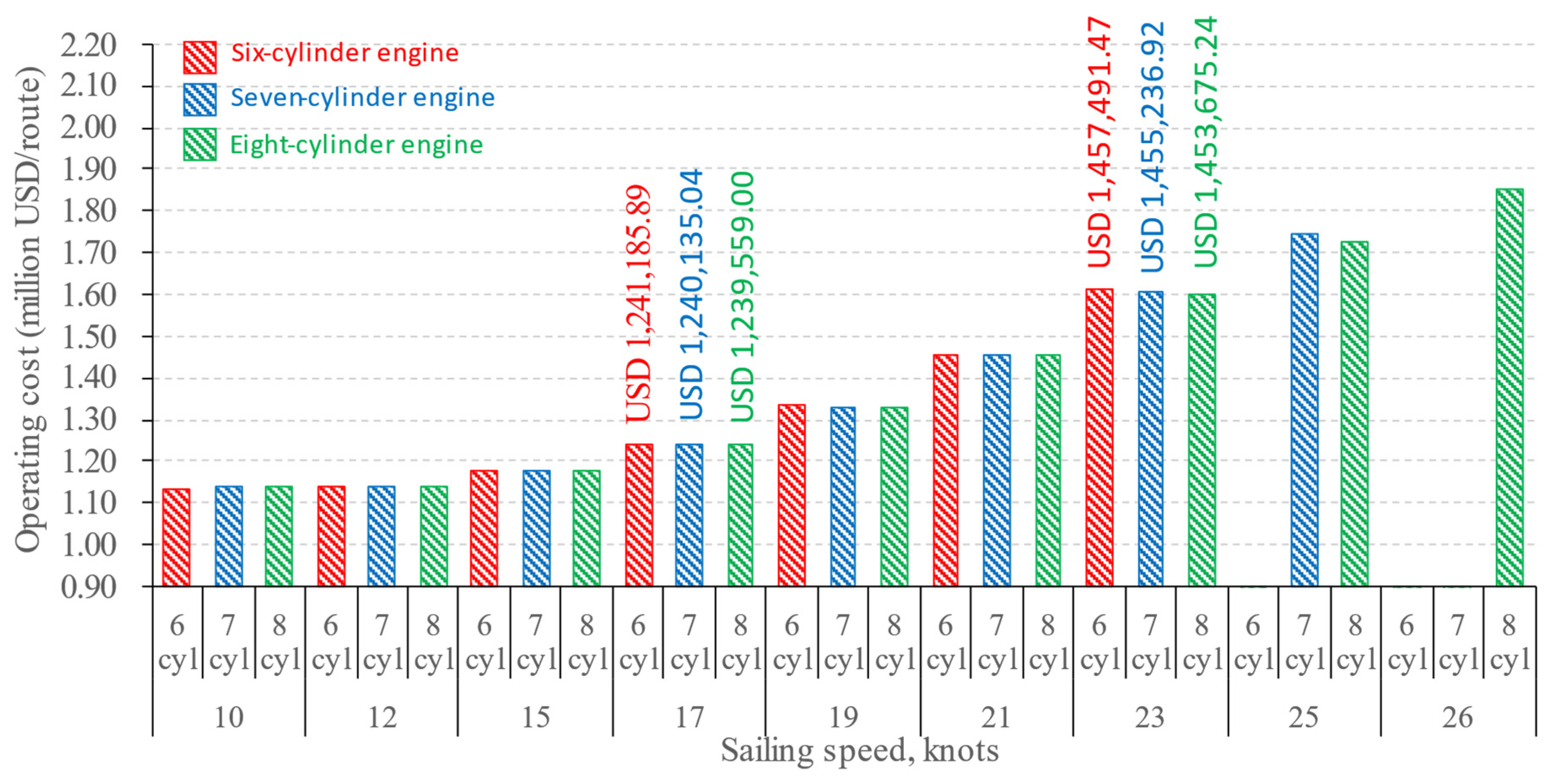

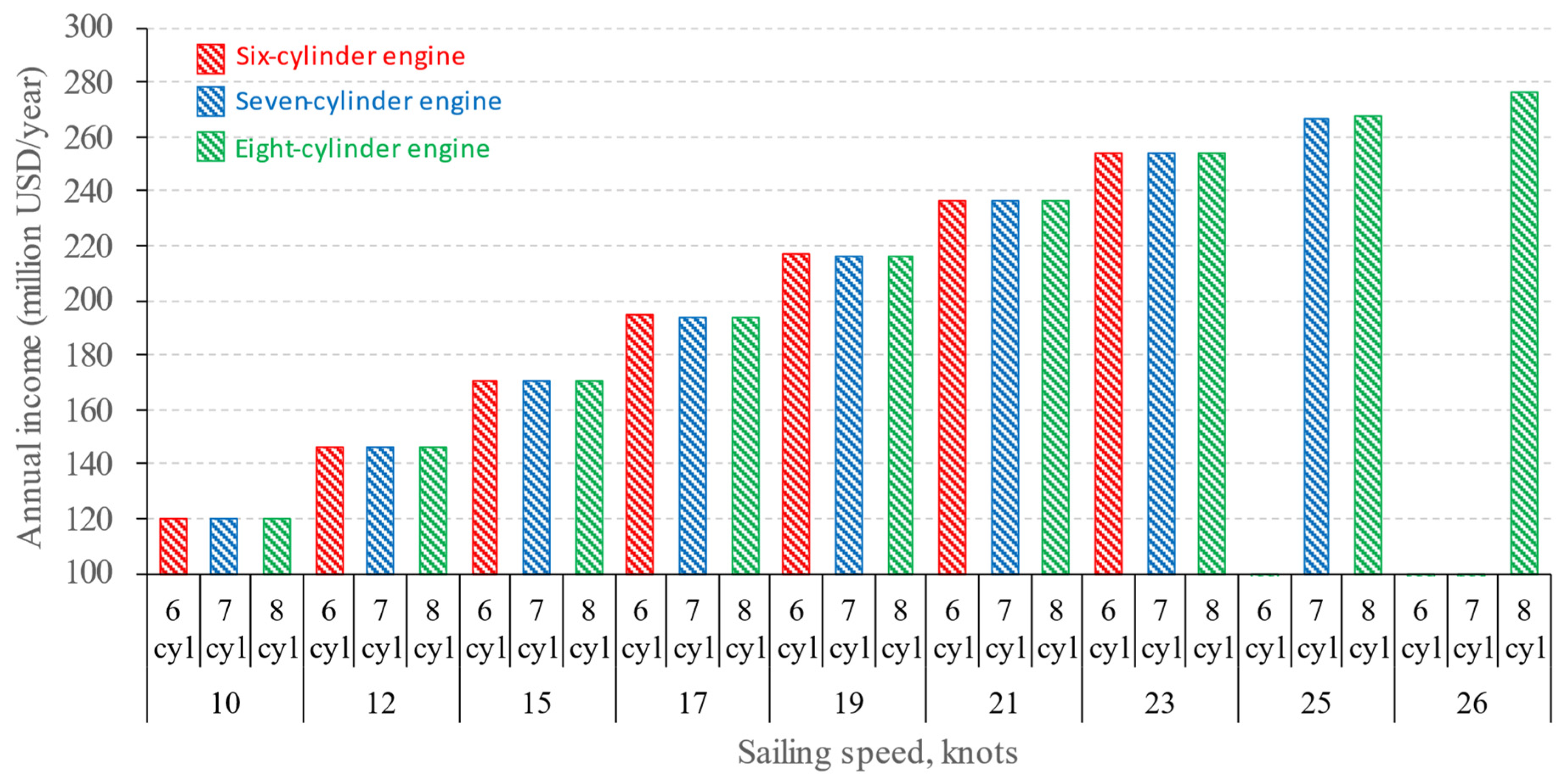

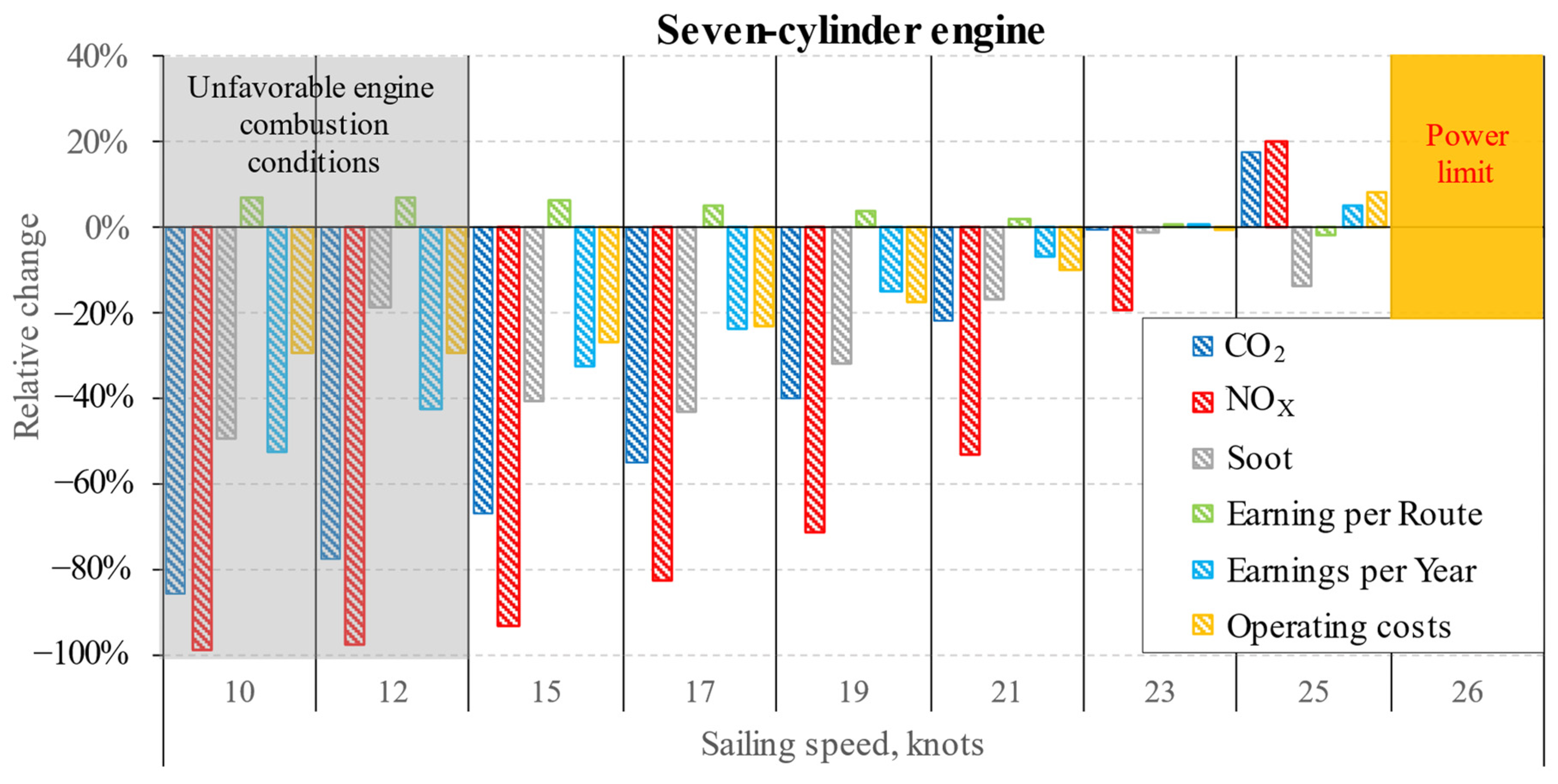

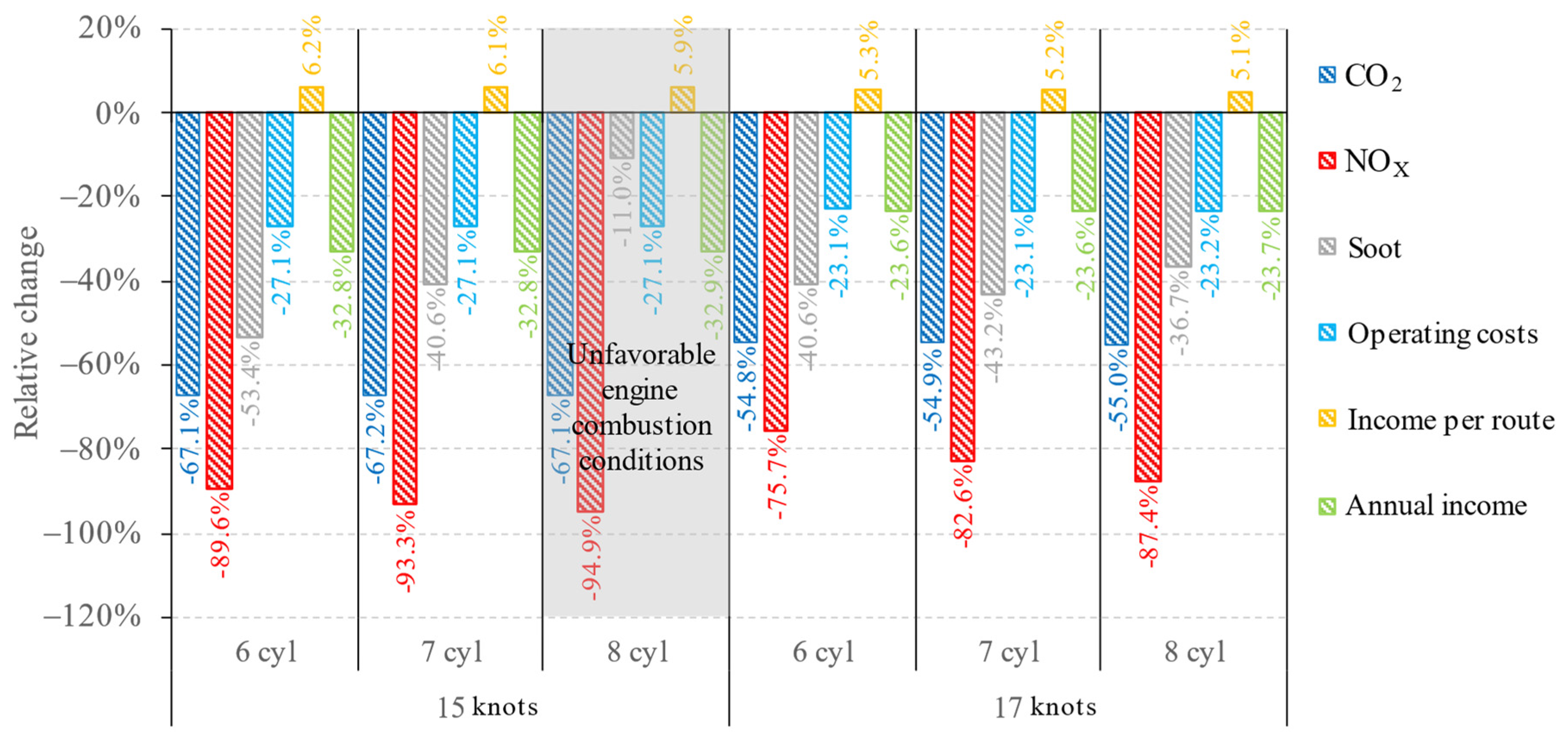
| Main Particular | Symbol | Unit of Measurement | Full Scale | Model Scale |
|---|---|---|---|---|
| Length between perpendiculars | LPP | m | 286.58 | 8.1460 |
| Length of waterline | LWL | m | 292.37 | 8.3107 |
| Breadth | B | m | 40 | 1.1370 |
| Draught at forward perpendicular | TF | m | 11.98 | 0.3405 |
| Draught at aft perpendicular | TA | m | 11.98 | 0.3405 |
| Draught at midship | TM | m | 11.98 | 0.3405 |
| Wetted surface area | S | m2 | 13,325 | 10.7668 |
| Displacement volume | V | m3 | 85,556 | 1.9650 |
| Longitudinal center of buoyancy (with respect to midship) | LCB | m | −5.07 | −0.1440 |
| Vertical center of buoyancy | ZCB | m | 6.62 | 0.1882 |
| Block coefficient | CB | - | 0.6231 | |
| Midship section coefficient | CM | - | 0.9850 | |
| Longitudinal prismatic coefficient | CP | - | 0.6317 | |
| Waterplane area coefficient | CWP | - | 0.7838 | |
| Propeller Particulars | Symbol | Measurement Unit | V-1124 (CPP) |
|---|---|---|---|
| Diameter | D | m | 0.2073 |
| Pitch ratio at 0.7R | P0.7R/D | - | 1.3 |
| Expanded blade area ratio | AE/A0 | - | 0.633 |
| Ratio of the hub diameter to the propeller diameter (hub ratio) | d/D | - | 0.2957 |
Disclaimer/Publisher’s Note: The statements, opinions and data contained in all publications are solely those of the individual author(s) and contributor(s) and not of MDPI and/or the editor(s). MDPI and/or the editor(s) disclaim responsibility for any injury to people or property resulting from any ideas, methods, instructions or products referred to in the content. |
© 2024 by the authors. Licensee MDPI, Basel, Switzerland. This article is an open access article distributed under the terms and conditions of the Creative Commons Attribution (CC BY) license (https://creativecommons.org/licenses/by/4.0/).
Share and Cite
Sjerić, M.; Tomić, R.; Martić, I.; Degiuli, N.; Grlj, C.G. Environmental and Economic Aspects of a Containership Engine Performance in Off-Design Conditions. Appl. Sci. 2024, 14, 4634. https://doi.org/10.3390/app14114634
Sjerić M, Tomić R, Martić I, Degiuli N, Grlj CG. Environmental and Economic Aspects of a Containership Engine Performance in Off-Design Conditions. Applied Sciences. 2024; 14(11):4634. https://doi.org/10.3390/app14114634
Chicago/Turabian StyleSjerić, Momir, Rudolf Tomić, Ivana Martić, Nastia Degiuli, and Carlo Giorgio Grlj. 2024. "Environmental and Economic Aspects of a Containership Engine Performance in Off-Design Conditions" Applied Sciences 14, no. 11: 4634. https://doi.org/10.3390/app14114634






